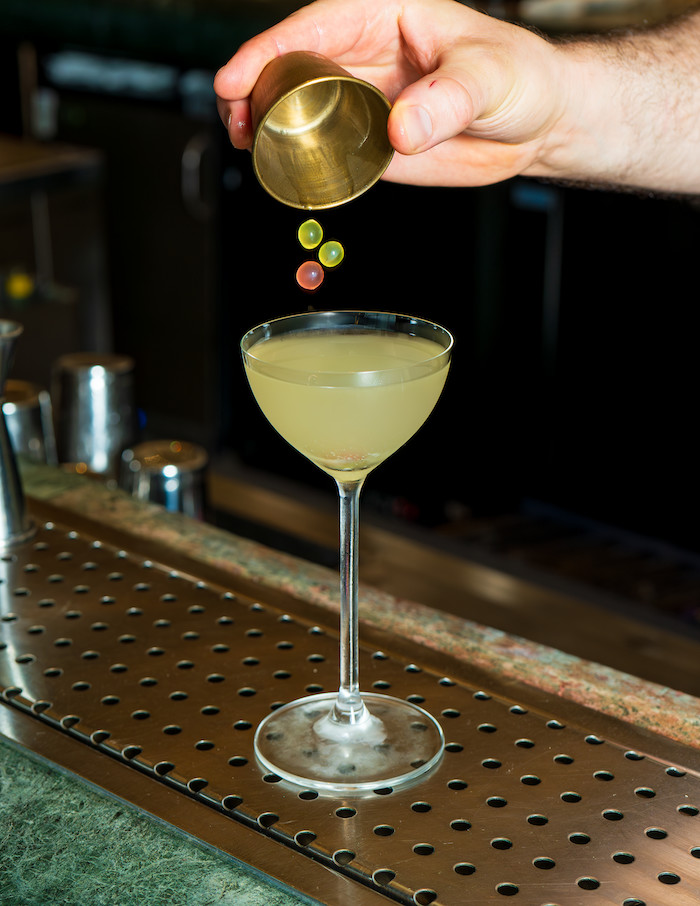
In the first of a new series of deep dives on modern cocktails, Tyler Zielinkski explains why Lyaness’s Unfiltered Martini is one of the best drinks to ever emerge from the Lyan bar.
There’s little place for convention in the Lyan bar universe. And, to be fair, it’s been that way since the group’s inception. Before Paris’s shit-hot De Vie, where ice is deemed a redundant ingredient, it was White Lyan that paved that path. Lyan bars have also “nuked” Negronis as a way to mimic the impact of time on a mixed drink, crafted curaçao from pig’s blood, used enzyme-rich sheep pancreas to kick off fermentation… and the list of zany innovation goes on.
While there’s surely some appeal in the novelty of these ingredients for curious imbibers, unlike many bars that use technique for technique’s sake, there’s always purpose and storytelling baked into each component developed by the Lyan bars.
Take Lyaness’s unctuous, Unfiltered Martini for example – a cocktail that’s recently become listed as a Lyaness “classic” after initially debuting on its 3.0 Cookbook menu in 2024. On the surface, it’s a minimalist take on the Martini, boasting only two ingredients: Boatyard vodka and “really good potato”. But beneath its elegant surface and unfiltered sake-like character – offering notes of vanilla, banana and tropical fruit – lies a cocktail that tells a story of flavour through the lens of biology and chemistry.
“Like with many things Lyan, we often start with very humble, everyday ingredients in an attempt to show that they too can be magnificent,” says Ryan Chetiyawardana, founder of the Lyan Bars, about the “really good potato” component. “We wanted to explore the balance between human cravings and what is good for us in a wider sense, including our microflora. So we looked towards macro food groups [carbohydrates, proteins, fats] and what this could mean for the human microbiome that collaborates with us in digestion, and therefore, in deliciousness.”
The team started the year-long R&D process by researching various blends of enzymes and bacteria that would emulate the workings of our digestive system.
“We opted for a fungal protease blend which replicates the functions of enzymes present in the human body for digestion, such as lipase, lactase and amylase, among many others,” says Chetiyawardana.
Alongside the enzymes, the team also explored the potential impact of different bacteria strains, which are also vitally important in the breaking down of food. Lactobacillus, a term most fermentation-savvy bartenders will be familiar with as it’s the bacteria responsible for lacto fermentation, has many strains – all of which offer unique explorations of flavour. For the processing of the potato, the bar used lactobacillus acidophilus, plantarum and casei.
“Each is selected for its unique qualities in aiding different aspects of the digestive process,” notes Chetiyawardana.
The process
Using Maris Piper potatoes specifically, the team peels, steams and purées them with water, then pitches the mashed potatoes – let’s call them what they are – with the blend of enzymes and bacteria before sealing the mixture in a vacuum bag.
The enzyme and bacteria-laden mashed potato is then gently cooked sous vide at body temperature – a clever detail that encapsulates Lyaness’s storytelling approach to ingredient development – for four hours, before being filtered and batched with Boatyard vodka. This allows flavours to marry, but also increases the shelf life of the ferment.
“We loved how we could create the profile of vanilla ice cream from Maris Piper potatoes, but we also wanted to make sure we didn’t lose the amazing texture we were able to capture,” says Chetiyawardana.
“We explored using a potato vodka, but we found this was too complementary – we preferred the elegance, body and richness of Boatyard‘s phenomenal vodka. Also, there was something amazing about a Martini riff where the sole two ingredients were potatoes and barley.”
To finish the cocktail, in lieu of the typical three olives, the Unfiltered Martini is served with three flavoured boba pearls: one peach, one pineapple and one lychee as a nod to the cocktail’s unlikely tropicality.
Chetiyawardana notes that, when fermenting, the key is to test, check results then, once you dial in the profile you want, control the variables through balancing the thresholds of temperature, pitching rates, substrate (ie volume of base food) and time to get a consistency you want.
“What our explorations in this area have shown is that there is no set template when working with bacteria and enzymes,” says Chetiyawardana. “Their interactions are difficult to predict and can have unwanted, or potentially dangerous, results.”
For example, the Lyaness team tried using the exact same combination of enzymes and bacteria on another macronutrient, avocado, and the results were deemed “not delicious”. But by tweaking the variables, the bar is beginning to understand how these ingredients might be used more beneficially.
Through considered fermentation and an unorthodox embrace of living ingredients, the Unfiltered Martini offers a quiet provocation: that the most refined experiences don’t come from what’s removed, but from what’s allowed to remain – a refreshing approach at a time when bars are heavily leaning on clarification and distillation.
“I love the variations on both vodka drinks and Martinis that we’ve had across the bars over the years (the Bone Dry Martini, the Imperfect Martini, the Cereal Martini, the Libecans Martini, the Silver Service Martini, etc), but to me this is a perfect drink,” Chetiyawardana claims.


